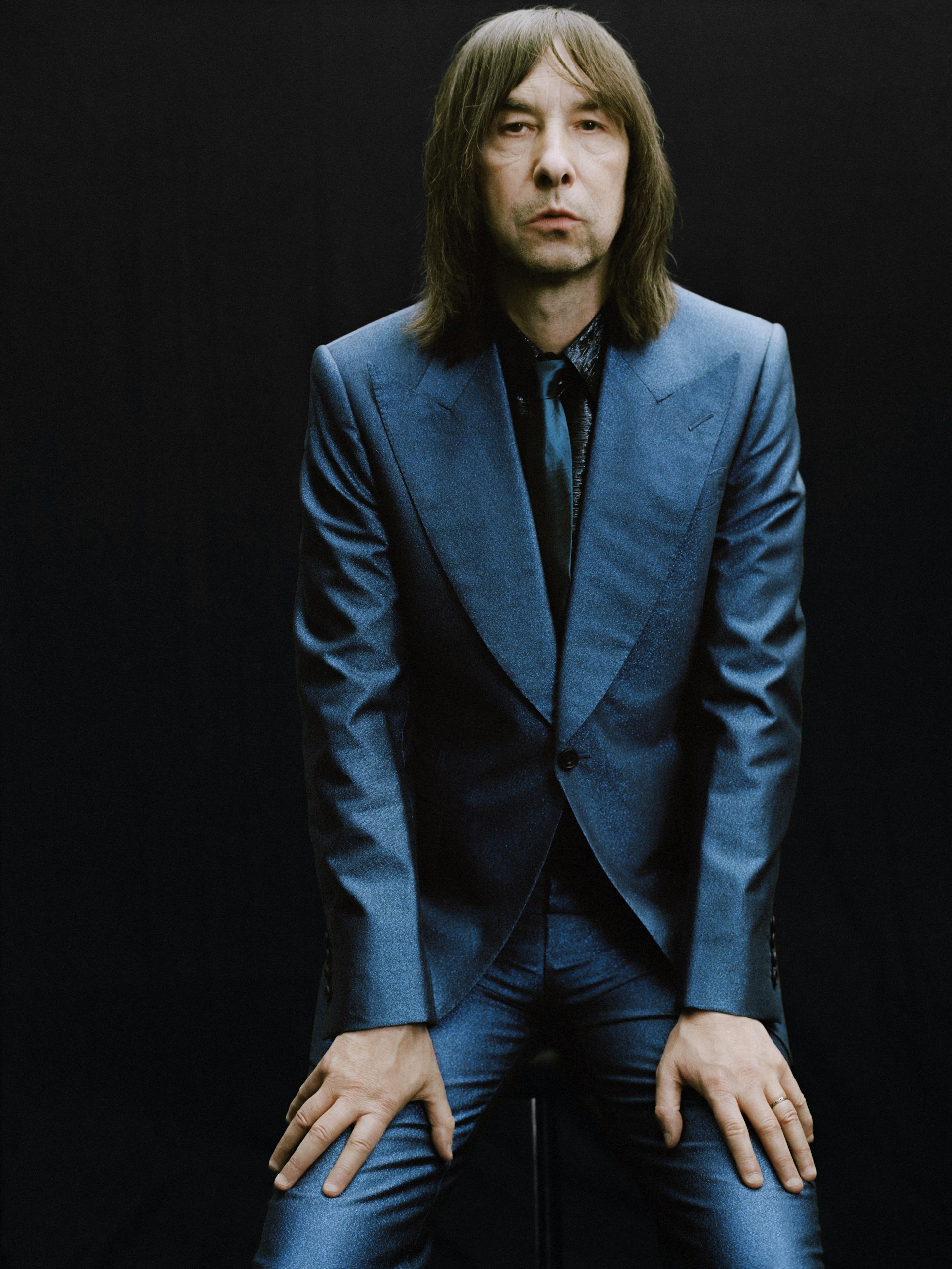Maurizio Cattelan
- Text by Tristan Manco
- Photography by Pierpaolo Ferrari

There’s a bit of a rebel in all of us, a latent urge to break the rules and raise a few brows. One man who has made a spectacular career in artistic rebellion is Italian visual prankster Maurizio Cattelan. Audacious and anti-authoritarian, Cattelan creates work that is dark, satirical and taboo-breaking. Take for example ‘La Nona Ora (1999)‘, a meticulously detailed sculpture of Pope John II being flattened by a meteorite. Or perhaps ‘L.O.V.E. (2011)‘, a four-metre-high marble hand that sits outside the Milan Stock Exchange flipping the bird. It’s comical stuff; a healthy poke of ridicule in the often stuffy world of high art. And here’s the best bit: the art establishment has lapped it up.
Cattelan began his creative career as a furniture-maker and after tinkering around with anti-functional design objects he was soon drawn into the art world, which he is said to have found “much more appealing”. But even when he was offered shows, a fear of failure lingered in his work. “I have been a failure for most of my life,” Cattelan has famously stated. “I couldn’t keep a job for more than two months. I couldn’t study: school was torture. And as long as I had to respect rules, I was a disaster. Initially art was just a way to try a new set of rules. But I was very afraid of failure in art as well.”
His first solo show in 1989 was a sign of things to come: lacking in confidence, Cattelan closed the gallery and left a sign on the door that read, ‘Torno subito’ – ‘Be back soon’. In a similar vein, during an exhibition years later at the de Appel arts centre in Amsterdam, he audaciously stole work from another artist’s show and displayed it under the title, ‘Another Fucking Readymade (1996)’. The Dutch police didn’t appreciate the post-Duchampian wit and he was politely asked to return the piece.
In spite of his disruptive tendencies, Cattelan began to develop a distinctive visual style characterised by a hyperrealist approach to sculpture. Using life-like waxworks and taxidermy, his sculptural installations portray a world that is both familiar yet absurd at the same time. Human and animal characters are presented in improbable scenarios, or at diminutive or exaggerated scale to shocking effect. One infamous piece titled ‘Him (2001)’ – a sculpture of Hitler as a young boy kneeling in prayer – may seem to cross the line, but in its boldness he attacks the abuse of power and failings of society. And then of course there’s ‘Novecento (1997)’, a taxidermy horse, which was hung unceremoniously from the ceiling of the Tate Modern in 1999. As is typical of Cattelan’s work, the hairy pendant elicited mixed reactions; was it offensive and in bad taste, or a tragic comment on the indignity of death?
Since settling in New York in 1993, Cattelan has flitted between living there and in Milan. Without a studio, he works in situ at exhibition spaces, incorporating the environment into his work. As he explained in 2005 to arts journal Sculpture Magazine, “Art should not be a space shut in on itself, but rather a magnetic field that attracts the energies of artists into space, and possibly into the cities in which they circulate. I’m searching for that magnetism, like a chemical reaction.”
And it seems New York is one city where Cattelan sees sparks. It was there that in 2002 he teamed up with curators Massimilano Gioni and Ali Subotnick to found The Wrong Gallery, a small non-commercial gallery space that was intended to be a “back door to contemporary art”. In a classic sideswipe at the inherently elitist contemporary art world, the gallery was kept locked at all times; if you wanted to see an exhibition, you had to peek through the glass. Despite or because of its subversive philosophy, The Wrong Gallery attracted a string of artists who playfully embraced the concept – like Polish interventionist Pawel Alhamer, who hired two illegal Polish immigrants to smash in the gallery door with a baseball bat every Saturday. In total, the door had to be replaced four or five times to which Cattelan is said to have remarked, “It’s a good way to keep the window cleaned!”
For Cattelan, the mystique and machinations of the gallery system is something to be toyed with. When The Wrong Gallery was evicted from its Chelsea address, it took up residency at the Tate Modern in 2005 where it carried on with its signature pranks, becoming a gallery within a gallery and a work of art in itself. And when The Wrong Gallery team were invited to curate the Berlin Biennale, they responded by audaciously setting up a fake Berlin branch of the successful Gagosian gallery franchise. Appropriating the gallery’s logo, they set up a bootleg space in a disused plumbers’ merchants to create the antithesis of the luxurious Gagosian brand.
And the pranks don’t stop at the gallery door. Request an interview with Cattelan and you may well find yourself sitting down with one of many imposters – fake Cattelans sent by Cattelan himself. A video featuring ‘an interview with the artist’ still circulates online, featuring an American who looks nothing like the Italian provocateur. Even with his most important retrospective to date – Maurizio Cattelan: All (Nov 2011 – Jan 2012) held at the Guggenheim Museum in New York – he remained resolutely unorthodox. With typical playfulness, Cattelan used the museum’s famous atrium like a giant puppet theatre and suspended his sculptures en masse in a vast tangled web. The result was a magnificent chaos that contrasted the usual reverence given to art.
It was during this retrospective that Cattelan announced he was retiring from art to concentrate on curating and publishing – an interest he’d pursued in the mid-nineties with Permanent Food, a publication that was created entirely using pages torn out of other magazines. Most recently in 2010, after collaborating on an art issue of W Magazine, Cattelan struck up a creative partnership with photographer Pierpaolo Ferrari to produce Toilet Paper, a mag that lampoons the visual language of glossy fashion and art magazines by combining commercial photography with twisted narratives: bloody fish-head shoes, giant dildos and a bird with its wing caught between scissor blades are just some of the jarring images described by Cattelan as a “mental outburst”.
And being completely mental seems to be working for old Cattelan. One of his most famous pieces – a taxidermy horse titled ’The Ballad of Trotsky’ – was auctioned off in 2004 by Sotheby’s for $2.8million. Cattelan insists he won’t see a penny of the sum. So, how does he deal with being at the peak of a global art market he professes to find so absurd? “It’s like going to sleep fourteen years old and waking up thirty,” Cattelan told The Guardian’s Sophie Arie in 2004. “Things that maybe seemed a joke before are now taken more seriously.”
Latest on Huck

How to shoot the world’s most gruelling race
Photographer R. Perry Flowers documented the 2023 edition of the Winter Death Race and talked through the experience in Huck 81.
Written by: Josh Jones

An epic portrait of 20th Century America
‘Al Satterwhite: A Retrospective’ brings together scenes from this storied chapter of American life, when long form reportage was the hallmark of legacy media.
Written by: Miss Rosen

Bobby Gillespie: “This country is poisoned by class”
Primal Scream’s legendary lead singer writes about the band’s latest album ‘Come Ahead’ and the themes of class, conflict and compassion that run throughout it.
Written by: Bobby Gillespie

Vibrant photos of New York’s Downtown performance scene
‘Balloons and Feathers’ is an eclectic collection of images documenting the scene for over two decades.
Written by: Miss Rosen

Picking through the rubble: Glimpses of hope in the US election results
Clambering through the wreckage of the Harris campaign, delving deeper into the election results and building on the networks that already exist, all hope is not gone writes Ben Smoke.
Written by: Ben Smoke

US Election night 2024 in Texas
Photographer Tom “TBow” Bowden travelled to Republican and Democratic watch parties around Houston, capturing their contrasting energies as results began to flow in.
Written by: Isaac Muk